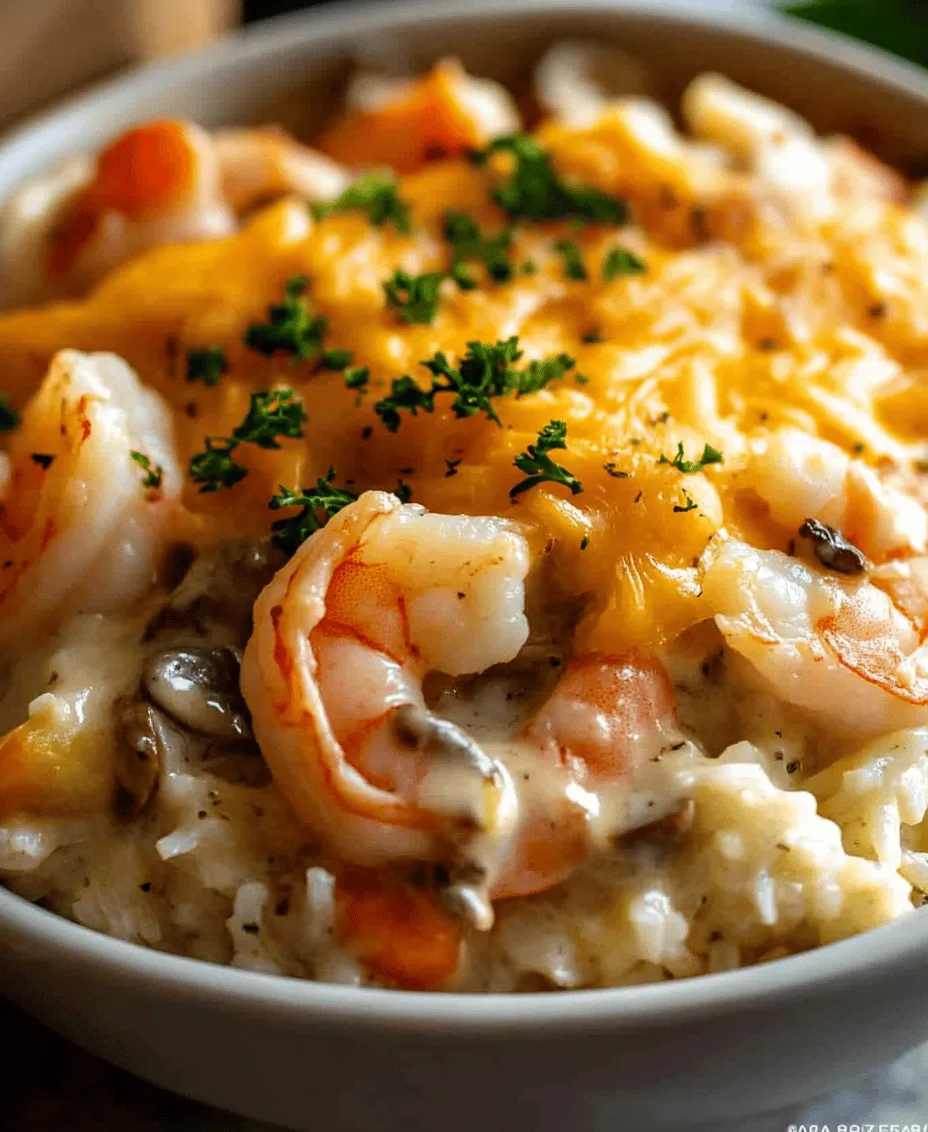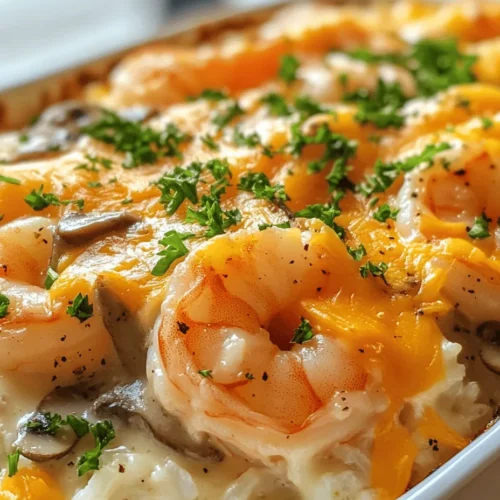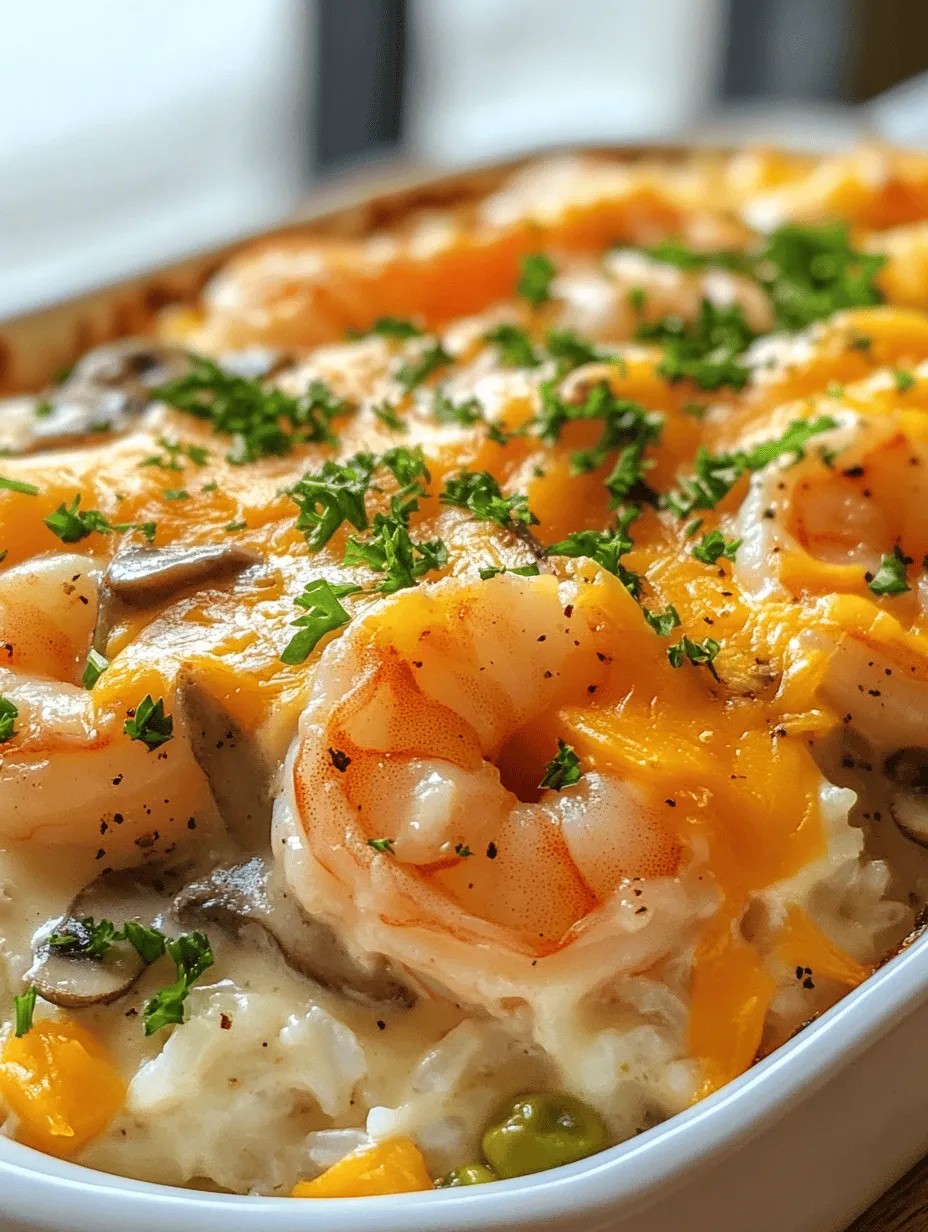Introduction
In today’s fast-paced world, finding the time to prepare a nutritious meal can often feel like a juggling act. That’s where quick and easy recipes come into play, especially for busy families and professionals. One such delightful dish is the Quick Shrimp Casserole—a vibrant, hearty meal that promises to satisfy your palate without consuming your entire evening. This recipe not only caters to your need for speed in the kitchen but also showcases the rich flavors and textures that shrimp brings to the table.
Shrimp is renowned for its versatility and ease of preparation, making it an ideal choice for a variety of dishes. Whether you’re a busy parent seeking to whip up a meal after a long day or a culinary enthusiast looking for a quick gourmet option, shrimp can elevate your dinner experience. Packed with protein and low in calories, shrimp not only tantalizes your taste buds but also contributes to a balanced diet. This casserole is designed to be a crowd-pleaser, blending the succulent taste of shrimp with wholesome ingredients that come together seamlessly in one pan.
Understanding Shrimp as a Key Ingredient
Shrimp is not just a delicious seafood option; it is also a nutritional powerhouse. Rich in high-quality protein, shrimp is an excellent source of essential nutrients, including omega-3 fatty acids, vitamin B12, selenium, and iodine. These nutrients support heart health, enhance brain function, and contribute to overall well-being. Furthermore, shrimp is low in calories and saturated fat, making it a popular choice for those looking to maintain a healthy lifestyle without sacrificing flavor.
When it comes to choosing shrimp, you’ll find a variety of types in the market, each offering its unique characteristics. The most common types include:
– Wild-Caught Shrimp: Often considered the superior choice for flavor, wild-caught shrimp are typically more sustainable. They can be found in various sizes, from small to jumbo, and are usually available fresh or frozen.
– Farm-Raised Shrimp: These shrimp are bred in controlled environments and are often more readily available. While they may lack some of the nuanced flavors of their wild counterparts, they can still be a delicious option for a quick meal.
– Key Varieties: Popular types include Gulf shrimp, Pacific white shrimp, and tiger shrimp, each with distinct flavor profiles. For casseroles, medium-sized shrimp work best, as they provide a balance of texture and flavor.
When selecting shrimp, consider whether you want fresh or frozen. Fresh shrimp can be fantastic if you have access to a good seafood market, but frozen shrimp can be just as nutritious and convenient. Here are some tips for selecting the best shrimp:
– Fresh Shrimp: Look for shrimp that have a mild, briny smell, and firm, translucent flesh. Avoid any shrimp that smell overly fishy or have a slimy texture.
– Frozen Shrimp: Choose shrimp that are flash-frozen immediately after being caught. Check the packaging for any signs of freezer burn and ensure that it’s free from added preservatives.
The Versatility of Casseroles
Casseroles have long been a staple in home cooking, and for good reason. They provide a one-dish solution that simplifies meal preparation and cleanup—ideal for busy nights when time is of the essence. The beauty of a casserole lies in its adaptability; you can easily modify it to align with your personal tastes or dietary needs. Whether you’re looking to incorporate more vegetables, prefer a different protein, or need a gluten-free option, casseroles can be tailored to meet your requirements.
The Quick Shrimp Casserole shines in its convenience. With just a few steps, you can create a comforting meal that is both filling and nutritious. The one-pan aspect of this recipe means less time spent in the kitchen and more time enjoying dinner with your family. Plus, casseroles are perfect for leftovers—simply reheat for a satisfying meal the next day.
Gathering Your Ingredients
To create a delicious Quick Shrimp Casserole, you’ll need a selection of key ingredients. Each component plays an essential role in building the flavors and textures of the dish. Here’s a detailed description of the ingredients you’ll use:
Shrimp: Types and Preparation Methods
As previously mentioned, shrimp serves as the star of this casserole. You can use either fresh or frozen shrimp, depending on availability. If using frozen shrimp, make sure to thaw them beforehand. To prepare shrimp for the casserole, simply peel and devein them if necessary, and pat them dry with a paper towel to remove excess moisture. This step ensures they will cook evenly and absorb the flavors of the casserole beautifully.
Cream of Mushroom Soup: Alternatives and Homemade Options
For a creamy base, cream of mushroom soup is a classic choice in casseroles. While store-bought options are convenient, you can also make a homemade version for a fresher taste. A simple recipe involves sautéing fresh mushrooms, onions, and garlic in butter, then thickening with flour and adding milk or vegetable broth to create a rich, creamy sauce. If you prefer a lighter option, consider using a cream of celery or chicken soup, or even a homemade white sauce as an alternative.
Cooked Rice: Suggestions for Variations
Rice is a foundational ingredient in many casseroles, providing bulk and a satisfying texture. For this recipe, you can use any type of cooked rice, including white, brown, or jasmine. If you’re looking for a healthier twist, consider substituting rice with quinoa or cauliflower rice, which will add additional nutrients and fiber to the dish. Make sure to prepare the rice according to package instructions before adding it to the casserole.
Cheddar Cheese: Other Cheese Options and Their Flavor Profiles
Cheddar cheese adds a creamy, indulgent element to the casserole. While sharp cheddar is a popular choice for its bold flavor, feel free to experiment with other cheeses such as Monterey Jack, mozzarella, or even a sprinkle of parmesan for a different flavor profile. Mixing cheeses can also create a delightful layer of complexity in taste, enhancing the overall enjoyment of the dish.
Frozen Mixed Vegetables: Benefits of Using Frozen Versus Fresh
Frozen mixed vegetables are a convenient addition to this casserole, providing essential vitamins and minerals while saving you the prep time of chopping fresh vegetables. They are typically flash-frozen at their peak ripeness, ensuring that they retain their nutrients. If you prefer fresh vegetables, feel free to substitute with options like bell peppers, corn, or peas. Just keep in mind that fresh vegetables may require a little more cooking time to become tender.
Milk: Dairy and Non-Dairy Alternatives
Milk is used in the casserole to add creaminess and help combine the ingredients. You can use any type of milk you prefer, including whole milk, skim milk, or even plant-based alternatives like almond or oat milk. If you are looking for a richer flavor, opt for whole milk or cream. Be mindful of the consistency, as non-dairy alternatives may have different thicknesses that may affect the final dish.
With all your ingredients gathered, you are ready to embark on the journey of creating this Quick Shrimp Casserole. Stay tuned for the next section, where we will dive into the step-by-step instructions that will guide you through preparing this delicious dish.

Spices: The Role of Garlic and Onion Powder in Enhancing Flavor
Incorporating spices into your cooking can elevate a dish from mundane to extraordinary, and in the case of our Quick Shrimp Casserole, garlic and onion powder are key players. These ingredients not only add depth and complexity to the flavor profile but also enhance the overall aromatic experience of the dish.
Garlic powder brings a rich umami flavor that complements the natural sweetness of shrimp, while onion powder provides a subtle sweetness and savory note that rounds out the dish beautifully. Together, they create a well-balanced base that ensures each bite is packed with flavor, making them essential ingredients in this quick and easy casserole.
Step-by-Step Cooking Instructions
Preheating the Oven: Importance and Correct Temperature
Before you begin any cooking, preheating your oven to 375°F (190°C) is crucial. This ensures that your casserole cooks evenly and achieves the desired level of doneness. An adequately preheated oven helps the ingredients meld together while keeping the shrimp tender and juicy. To check if your oven has reached the correct temperature, use an oven thermometer for accuracy, as some ovens may vary in their actual temperature settings.
Cooking the Shrimp: Techniques to Ensure Perfect Doneness
To achieve perfectly cooked shrimp, start by using raw, peeled, and deveined shrimp. For this recipe, you can use fresh or frozen shrimp; if using frozen, ensure they are thawed completely.
1. Sautéing Technique: Heat a tablespoon of olive oil in a skillet over medium heat. Add the shrimp, seasoning them lightly with salt, pepper, and a pinch of garlic powder. Sauté for 2-3 minutes until they turn pink and opaque. Be careful not to overcook; shrimp should be firm but tender. Remove them from heat and set aside.
2. Alternative Cooking Method: If you prefer, you can also boil the shrimp in salted water for 1-2 minutes until they turn pink. Immediately transfer them to an ice bath to stop the cooking process. This method guarantees that your shrimp remain juicy and flavorful.
Preparing the Casserole Mixture: Proper Mixing Methods for Even Distribution
While the shrimp cools, it’s time to prepare the casserole mixture. In a large mixing bowl, combine your base ingredients, which typically include cooked rice, cream of mushroom soup, and shredded cheese. Add in the sautéed vegetables—like bell peppers and peas—along with the seasonings: garlic powder, onion powder, paprika, and a dash of cayenne for heat if desired.
1. Mixing Technique: Use a spatula or wooden spoon to gently fold the ingredients together. Ensure that the soup coats all the rice and vegetables evenly without breaking down the shrimp or other delicate components. The goal is to create a cohesive mixture that will bake beautifully in the oven.
Incorporating Shrimp: Best Practices for Folding Ingredients
Once your casserole mixture is well combined, it’s time to fold in the shrimp.
1. Gentle Incorporation: Carefully add the cooked shrimp to the mixture, using a folding motion rather than stirring vigorously. This prevents the shrimp from becoming mushy and ensures they are evenly distributed throughout the casserole.
2. Final Touches: After folding in the shrimp, taste the mixture and adjust the seasoning as necessary. This is a great point to add more salt, pepper, or spices based on your preference.
Baking the Casserole: Understanding Baking Times and Indicators for Doneness
Transfer your shrimp and rice mixture into a greased baking dish, spreading it out evenly. Top it with a generous sprinkle of shredded cheese for a beautifully melted finish.
1. Baking Time: Place the casserole in the preheated oven and bake for approximately 25-30 minutes. Keep an eye on it in the last few minutes; you want the cheese to be golden and bubbly, which indicates that the casserole is thoroughly heated and ready to serve.
2. Testing for Doneness: To check if the casserole is done, insert a knife into the center. If it comes out hot and clean, your dish is ready. If not, give it another 5 minutes in the oven.
Serving Suggestions and Pairings
When it comes to serving your quick shrimp casserole, consider adding complementary side dishes and beverages to enhance the meal experience.
Ideas for Side Dishes
– Fresh Salad: A light, crisp salad with mixed greens, cherry tomatoes, and a lemon vinaigrette pairs beautifully with the richness of the casserole. The acidity from the dressing balances the creamy elements of the dish.
– Garlic Bread: Serve with warm garlic bread or rolls to soak up any delicious remnants of the casserole, adding a comforting touch to the meal.
– Steamed Vegetables: Lightly steamed green beans, broccoli, or asparagus can provide a nutritious and colorful contrast to the casserole.
Beverage Pairings
– White Wine: A chilled glass of Sauvignon Blanc or Pinot Grigio complements the shrimp’s flavors and enhances the overall dining experience.
– Sparkling Water: For a non-alcoholic option, serve sparkling water with a slice of lemon or lime. The bubbles and acidity will refresh your palate.
Presentation Tips for Serving the Casserole
– Garnish: Consider garnishing the casserole with freshly chopped parsley or chives for a pop of color and added freshness.
– Individual Portions: For a more sophisticated presentation, serve the casserole in individual ramekins, allowing each guest to have their own portion.
Nutritional Information
Understanding the nutritional profile of your meal can help you make informed choices, especially when it comes to balancing indulgence with health.
Breakdown of Calories and Macronutrients Per Serving
A typical serving of this shrimp casserole (approximately one cup) contains around 350-400 calories, depending on the specific ingredients used. It generally includes:
– Protein: Approximately 25 grams from shrimp and cheese.
– Carbohydrates: About 40 grams from rice and other ingredients.
– Fats: Roughly 15 grams, primarily from cheese and oil.
Health Benefits of the Ingredients Used in the Casserole
– Shrimp: High in protein and low in calories, shrimp is a lean source of essential nutrients, including omega-3 fatty acids, which are beneficial for heart health.
– Brown Rice: If you opt for brown rice, you’ll gain additional fiber, which supports digestive health and provides sustained energy.
– Vegetables: The inclusion of vegetables adds vitamins, minerals, and antioxidants, making this casserole not just delicious but also nutritious.
Suggestions for Making the Dish Healthier or More Indulgent
– Healthier Version: Substitute regular rice with quinoa or cauliflower rice for a low-carb option. Use low-fat cheese and cream of mushroom soup to reduce calories.
– Indulgent Version: For an extra creamy texture, consider adding a dollop of sour cream or a sprinkle of crispy bacon on top before baking.
Storing and Reheating Leftovers
Leftovers from your shrimp casserole can be a convenient and delicious option for future meals. Here are tips for storing and reheating effectively.
Best Practices for Storing Leftovers to Maintain Freshness
1. Cool Down: Allow the casserole to cool to room temperature before storing it to prevent condensation from forming in the container.
2. Airtight Containers: Transfer your leftovers into airtight containers. This will help maintain moisture and prevent the casserole from absorbing other odors in the refrigerator.
3. Refrigeration: Store in the fridge for up to 3-4 days. If you want to keep it longer, consider freezing it instead.
Techniques for Reheating the Casserole Without Drying It Out
1. Oven Reheating: Preheat your oven to 350°F (175°C). Cover the casserole with aluminum foil to retain moisture and heat for about 20 minutes or until warmed through.
2. Microwave Reheating: If you’re short on time, use the microwave. Place a portion on a microwave-safe plate, cover it with a damp paper towel, and heat in 30-second intervals until hot.
Alternative Meal Ideas Using Leftover Casserole
– Shrimp Quesadillas: Use leftover casserole as a filling for quesadillas. Just add cheese and grill until crispy for a quick lunch.
– Casserole Stuffed Peppers: Hollow out bell peppers and fill them with leftover casserole, then bake until the peppers are tender for a nutritious meal.
Conclusion
In summary, our Quick Shrimp Casserole is a versatile and satisfying dish perfect for busy weeknights. With its straightforward preparation and delightful flavors, it stands out as a go-to option for families and individuals alike. The combination of succulent shrimp, creamy rice, and aromatic spices delivers comfort food in a flash, making it a beloved recipe for many.
Whether you’re enjoying it fresh out of the oven or repurposing leftovers into new meals, this casserole proves to be both delicious and practical. We encourage you to try this recipe for your next busy night and experience the joy of a meal that’s as quick to prepare as it is enjoyable to eat.


